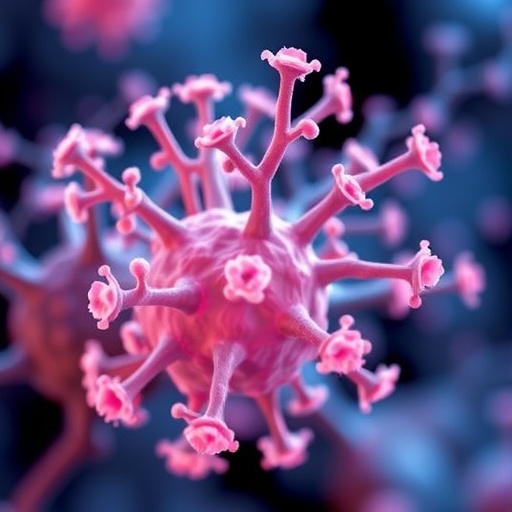In the relentless pursuit of advanced cancer therapeutics, antibody–drug conjugates (ADCs) have carved a significant niche due to their ability to selectively deliver potent cytotoxic agents directly to tumor cells. Despite their clinical success, conventional ADCs face notable challenges that hinder their broader application. Primarily, these challenges include limitations in incorporating less-potent payloads, constraints in drug mechanisms of action, inflexible drug release profiles, and narrow tunability of drug-to-antibody ratios (DARs). Addressing this complex array of hurdles, a groundbreaking development has emerged in the form of antibody–bottlebrush prodrug conjugates (ABCs), a transformative platform poised to redefine precision oncology.
Traditional ADCs rely on the conjugation of cytotoxic drugs to antibodies with relatively low DARs, typically in the range of two to four, to maintain stability and avoid aggregation or rapid clearance. However, such limited drug payloads necessarily restrict the therapeutic window and reduce the potential efficacy, especially against tumors with heterogeneous antigen expression or drug resistance. Moreover, the structural attributes of ADCs restrict the diversity of payload chemistry, potentially hampering the integration of novel drug classes that differ substantially in potency or require unique release mechanisms. The recently introduced ABC technology ingeniously circumvents these limitations by reimagining the conjugation architecture at the molecular scale.
At the heart of the ABC design lies a compact, bivalent bottlebrush prodrug that serves as an enhanced drug-attachment platform. This bottlebrush prodrug acts as a branched polymer scaffold, densely decorated with polyethylene glycol (PEG) side chains and cleavable drug linkers. Crucially, the terminal end of this polymeric bottlebrush is covalently linked to an IgG1 monoclonal antibody, preserving the antibody’s native targeting and immune-effector functions while delivering unprecedented drug payload capacity. This innovative bioconjugation strategy enables a tunable DAR that can exceed traditional ADC ratios by up to two orders of magnitude, thereby dramatically amplifying the therapeutic payload delivered per antibody molecule.
The synthesis of ABCs is characterized by remarkable versatility and scalability. Researchers demonstrated the platform’s adaptability by producing over ten distinct ABC variants targeting clinically relevant antigens such as human epidermal growth factor receptor 2 (HER2) and mucin 1 (MUC1). What stands out in this approach is the inclusion of payloads spanning a wide spectrum of potencies, from highly cytotoxic compounds to those with modest activity. This broad adaptability evidences the platform’s ability to fine-tune therapeutic action while mitigating off-target toxicity through controlled drug release, an Achilles heel for many conventional ADCs.
Moreover, the ABC platform introduces diverse drug release mechanisms embedded within the bottlebrush’s design, which can be chemically tailored to respond to specific tumor microenvironmental cues or intracellular conditions. The cleavable linkers integrated into the PEG branches are engineered for stimuli-responsive degradation, ensuring precise payload liberation only upon engagement with the tumor milieu, thereby reducing systemic exposure. This level of control over drug release kinetics is a quantum leap beyond current ADC technologies that often display premature drug release or suboptimal activation.
In addition to drug payloads, the ABCs incorporate imaging agents within the bottlebrush structure, facilitating real-time visualization and tracking of therapeutic distribution and target engagement. This multimodal functionality paves the way for theranostics, where diagnostic and therapeutic modalities converge to optimize treatment regimens. Furthermore, the inclusion of photocatalysts embedded in the bottlebrush architecture allows for proximity-based labeling, a cutting-edge technique to map the ABC interactome at the molecular interface within target cells and tissues. This capability provides unprecedented insights into ADC cellular processing, uptake dynamics, and interaction networks.
One of the most compelling facets of ABC technology is its enhanced target engagement and cellular uptake compared to traditional ADCs. Experimental models revealed that ABCs exhibit superior binding avidity to antigen-positive tumor cells, reflecting the multivalent nature of the bottlebrush conjugation scaffold. This high-avidity interaction translates into increased internalization rates, ensuring more efficient intracellular delivery of cytotoxic payloads. Enhanced uptake coupled with tunable, high DARs culminates in markedly improved therapeutic efficacy in preclinical tumor models, particularly those resistant or refractory to existing HER2-targeted ADCs.
The compactness and molecular architecture of ABCs confer notable advantages in pharmacokinetics and manufacturability. The PEGylated bottlebrush not only stabilizes the conjugate to prevent aggregation but also improves solubility and reduces recognition by the immune system, thus extending circulation time. These properties facilitate streamlined manufacturing pipelines amenable to industrial-scale production, an essential consideration for clinical translation. The modular nature of the bottlebrush design further enables rapid customization to different antibodies, payloads, and adjunct functional groups, accelerating the development cycle for new targeted therapies.
Beyond oncology, the ABC framework possesses promise for broader biomedical applications. Its ability to integrate photocatalysts and imaging moieties combined with high drug payload flexibility suggests utility in targeted delivery of biologics, gene-editing tools, or combination therapies that require precise spatiotemporal control. The proximity-based catalytic labeling feature opens new avenues in mapping antibody interactions in vivo, advancing fundamental biological research on antibody engagement in complex tissue environments.
While the ABC technology is still navigating preclinical development stages, its robust performance across diverse payloads and target antigens augurs well for future clinical impact. The platform’s design elegantly addresses historical limitations of ADCs, marrying high drug loading with controlled release and advanced functionalization in a single molecular entity. This synergy of chemical engineering, polymer science, and bioconjugation represents a new frontier in antibody-based therapeutics that is poised to deliver safer, more efficacious treatments for cancer patients.
The progress documented in recent studies underscores the significance of interdisciplinary collaboration between chemists, molecular biologists, and clinicians in driving innovation at the interface of drug design and therapeutic delivery. By leveraging the unique structural advantages of bottlebrush polymers conjugated to antibodies, researchers have opened doors to complex, multifunctional drug conjugates that were previously inconceivable within the constraints of traditional ADC paradigms.
In conclusion, antibody–bottlebrush prodrug conjugates stand as a transformative advance in targeted cancer therapy, dramatically expanding the chemical and functional diversity accessible in antibody-mediated drug delivery. Their ability to sustain high drug loadings, incorporate multiple therapeutic modalities, and deliver payloads with precision promises to overcome the longstanding clinical limitations of ADCs. As ABC technology advances towards clinical trials, it heralds a new era of biopharmaceutical innovation with profound implications for personalized oncology and beyond.
Subject of Research: Antibody–bottlebrush prodrug conjugates as next-generation targeted therapeutics for cancer treatment.
Article Title: Antibody–bottlebrush prodrug conjugates for targeted cancer therapy
Article References:
Liu, B., Nguyen, H.VT., Jiang, Y. et al. Antibody–bottlebrush prodrug conjugates for targeted cancer therapy. Nat Biotechnol (2025). https://doi.org/10.1038/s41587-025-02772-z
Image Credits: AI Generated
Tags: antibody-bottlebrush prodrugsantibody-drug conjugateschallenges in ADC developmentcytotoxic agent delivery methodsdrug delivery systems for cancerdrug-to-antibody ratio optimizationnovel cancer therapeutic strategiesovercoming drug resistance in tumorspayload diversity in cancer treatmentsprecision oncology advancementsprodrugs for enhanced efficacytargeted cancer therapy innovations





